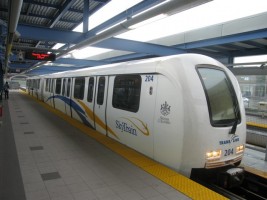
Rohr 1000 Series car departing Grosvenor, April 10, 2000
As I wrote yesterday, the process of retiring and scrapping WMATA’s 40 year old 1000 Series railcars has started. These cars were built by Rohr in the 1970s and have been carrying commuters and tourists alike since Metrorail opened on March 27, 1976. They are my favorite WMATA rolling stock and I’ve known for some time that this event in their lives would arrive someday.
In the Washington Post story about the scrapping, Metro spokesperson Dan Stessel says “The 1Ks have served this region for four decades. . . . I think people will eventually look back on them the way people in other cities, with more mature transit systems, look back with delight on their historic rail cars.” Unfortunately, Stessel is also quoted as saying that the agency has no plans to preserve any of the Rohrs.
Many transit agencies preserve retired equipment, perhaps most notably the New York City Transit Authority and Transport for London. NYCTA operates a museum in an abandoned station in Brooklyn and runs some of the system’s retired trains several times a year. The London Transport Museum is a major tourist attraction and features all sorts of buses and trains on static display. The London museum also has an annex in Acton that houses more of the collection that is open to the public twice a year. While this is the first time WMATA is retiring rail equipment, it has retired many buses over the years and preserves some of them in a historic fleet. However, if Stessel’s vision that someday, Washingtonians look back fondly on the Rohrs is to be reality, the prospects are greatly improved if some of the cars are preserved. Furthermore, scrapping an entire fleet of railcars is an irreversible decision that cannot be undone once all the cars are gone.

Thousands come out to ride the vintage train of 1930s equipment in New York City each December. Wouldn’t it be great if WMATA could roll out the 1000 series for special occasions in the future, even after they are retired from regular service?
I have spoken with some other transit fans in the DC area who are interested in seeing if there is some way that at least one pair of 1000 Series cars can be preserved. Several ideas have been suggested for how to do this:
- Petition WMATA to consider keeping a pair or two for preservation purposes and run them on special occasions
- Work with a local museum (such as the National Capital Trolley Museum or the DMV Mass Transit Museum) to see if they can take the lead in working with WMATA to preserve a pair of 1000 Series cars (either as a part of their own collections or through some other sort of arrangement with WMATA)
There have been several threads and email discussions with preliminary thoughts on how to make this happen. My idea is to try concentrating that discussion in a single place as people interested in this project come together, think of a strategy, and mobilize to make it happen. It can be this website, or another if somewhere else makes more sense.
Do you have thoughts on either one of the ideas listed above, or a different suggestion? Do you have a contact at WMATA, at one of the organizations listed above, or know of someone else who might be interested in this effort? Do you have something else relevant to this conversation to add? Might you be able to volunteer a bit of time here and there to help with this effort? Do you know someone who might be interested in any of the previous questions with whom you could share this post? Feel free to write a comment below, or e-mail me directly using this form. I look forward to seeing what we can do with regards to this potential project!







